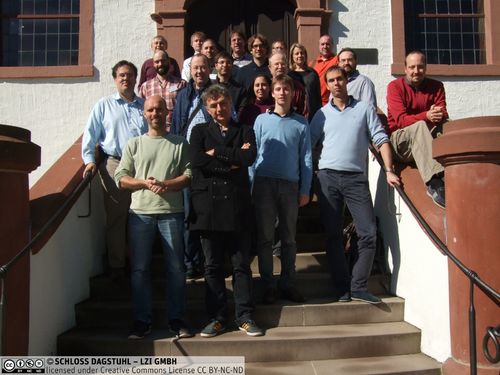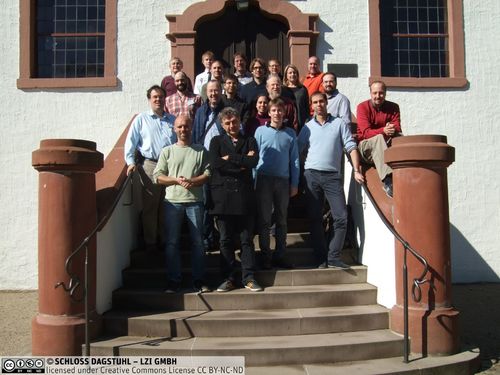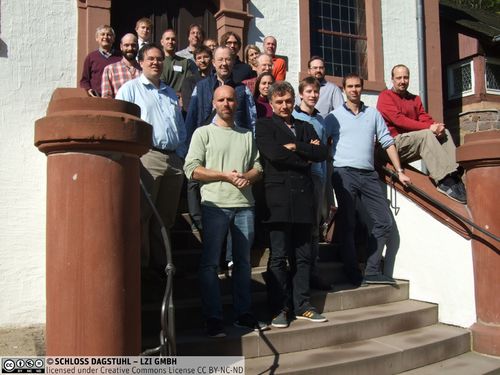Dagstuhl-Seminar 15402
Self-assembly and Self-organization in Computer Science and Biology
( 27. Sep – 02. Oct, 2015 )
Permalink
Organisatoren
- Vincent Danos (University of Edinburgh, GB)
- Heinz Koeppl (TU Darmstadt, DE)
Kontakt
- Andreas Dolzmann (für wissenschaftliche Fragen)
- Susanne Bach-Bernhard (für administrative Fragen)
Programm
Distributed systems without central coordination are abundant in biology. Generally, they involve a collection of agents that locally interact or self-organize in order to realize a certain collective behavior. Examples include self-assembly systems, where through the successive attachment of small building blocks large well-defined geometric structures can be formed. Currently, we see the trend of man-made systems in computer science and engineering to become more and more distributed - closer resembling self-organizing biological or physical systems.
This Dagstuhl Seminar aims to bring together researchers working in the areas of self-propelled particle systems, collective animal behavior, networked dynamical systems, molecular self-assembly, algorithmic self-assembly, graph-rewriting grammars, multi-agent systems, and swarm robotics. Although the methods and addressed questions differ, the unifying theme of all these areas is the distributed, granular nature of the considered systems and the emergence of certain global behavioral features.
Goals of this seminar are the exchange of latest advances in the respective areas and the identification of common grounds in terms of mathematical methodology and problem statements through the development of new abstract formal models. Featured reports on actual physical and biological realizations of self-assembling and self-organizing systems at the seminar will be instrumental to guide such formalization. More specifically, the seminar should shed light on one particular question of fundamental importance: How do we determine the local interactions of agents given a certain predetermined behavior of the collective? This inverse problem is key to the synthesis of novel self-organizing systems in technological domains but also to the understanding natural self-organizing systems.
The seminar is truly interdisciplinary and will bring together computer scientists, physicists, biologists, engineers and mathematicians. It will feature tutorial talks from the various domains to ensure a common ground for discussions. The seminar is ideally suited to identify novel challenging problems at domain boundaries and to initiate interdisciplinary collaborations.
The Seminar brought together researchers from molecular biology, molecular modeling and theoretical computer scientists with interest in formal models of molecular computation and self-organization. Molecular biology provides a rich substrate to implement molecular computation and complex self-assembly algorithms. The Seminar featured several talks on DNA-assembly systems, that to-date represents the most advanced molecular substrate for self-assembly. The increase in the achieveable complexity of such molecular structures asks for a formal description and analysis of those systems using methods from theoretical computer science. The Seminar was successful in identifying common problem statements and in establishing a common scientific language. Apart from self-assembly, the broader term self-organization was mostly represented by research on swarming or self-propelled particle (SPP) models. The common feature of SPP systems and self-assembly is the emergence of global structures through local interaction rules (self-assembled structure vs swarms or flocks). One contribution also featured the combination of swarming and self-assembly system in terms of nucleation studies. Moreover, novel methodological overlap between simulation algorithms for molecular self-assembly and simulation algorithms for SPP systems were identified and elaborated during the workshop.
The seminar was structured as a regular workshop with morning and afternoon sessions but plenty of time was allocated for discussions after each talk. For the first such Dagstuhl Seminar no working groups were defined. For follow-up Seminars on the same topic we aim to additionally define working groups that may also deliver preliminary research results and initiation of new collaborations.
Although the workshop was very interdisciplinary we were able to arrange the presentations into sessions of a coherent theme. The feedback of participants was extremely positive, stating that they could really profit from the technical discussions that accompanied every presentation and that were performed in the free time. Correspondingly, several new collaborations across disciplines were initiated at the seminar.
 Vincent Danos and Heinz Koeppl
Vincent Danos and Heinz Koeppl
- Jacob Beal (BBN Technologies - Cambridge, US) [dblp]
- Carsten Beta (Universität Potsdam, DE)
- Koan Briggs (University of Kansas, US)
- José Antonio Carillo (Imperial College London, GB)
- Matthew Cook (Universität Zürich, CH & ETH Zürich, CH) [dblp]
- Maria Rita D'Orsogna (California State University - Northridge, US) [dblp]
- Vincent Danos (University of Edinburgh, GB) [dblp]
- Hanno Hildmann (NEC Laboratories Europe - Heidelberg, DE) [dblp]
- Jonathan P. Hill (National Institute for Materials Science - Ibaraki, JP) [dblp]
- Heinz Koeppl (TU Darmstadt, DE) [dblp]
- Nikita Kruk (TU Darmstadt, DE)
- Emmanuel Levy (Weizmann Institute of Science - Rehovot, IL) [dblp]
- Yuri Maistrenko (National Academy of Sciences of Ukraine - Kiev, UA) [dblp]
- Vincent Noireaux (University of Minnesota - Minneapolis, US) [dblp]
- Matthew J. Patitz (University of Arkansas - Fayetteville, US) [dblp]
- John H. Reif (Duke University - Durham, US) [dblp]
- Matthias Sachs (University of Edinburgh, GB)
- Christian Scheideler (Universität Paderborn, DE) [dblp]
- Rebecca Schulman (Johns Hopkins University - Baltimore, US) [dblp]
- Friedrich Simmel (TU München, DE) [dblp]
- Adrian Sosic (TU Darmstadt, DE) [dblp]
- Sandro Stucki (EPFL - Lausanne, CH) [dblp]
- Petr Sulc (Rockefeller University - New York, US) [dblp]
- Serhiy Yanchuk (Weierstraß Institut - Berlin, DE) [dblp]
Klassifikation
- data structures / algorithms / complexity
- modelling / simulation
- networks
Schlagworte
- Self-assembly
- self-organization
- self-* systems
- concurrency
- graph-rewriting grammars Topics: Modelling/simulation




 Creative Commons BY 3.0 Unported license
Creative Commons BY 3.0 Unported license
